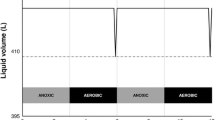Abstract
Thermophilic anaerobic treatment of sulphur-rich paper mill wastewater (0.8-3.1 gCOD/l, 340–850 mgSO4/l; COD:SO4 3.4-5.3) was studied in three laboratory-scale, upflow anaerobic sludge blanket (UASB) reactors and in bioassays. The reactors were inoculated with non-adapted thermophilic granular sludge. In the bioassays, no inhibition of the inoculum was detected and about 62% COD removal (sulphide stripped) was obtained. About 70 to 80% of the removed COD was methanised. In the reactors, up to 60–74% COD removal (effluent sulphide stripped) was obtained at loading rates up to 10–30 kgCOD/m3d and hydraulic retention times down to 6 to 2 hours. The effluent total sulphide was up to 150–250 mg/l. Sulphide inhibition could not be confirmed from the reactor performances. The results from bioassays suggested that both the inoculum and sludge from the UASB reactor used acetate mainly for methane production, while sulphide was produced from hydrogen or its precursors.
Similar content being viewed by others
References
Ahring BK (1994). Status on science and application of thermophilic anaerobic digestion. Wat.Sci.Tech. 30(12): 241–249
Ahring B, Rintala J, Nozhevnikova A & Matharani IM (1995) Metabolism of acetate in thermophilic (55 °C) and extreme thermophilic (70 °C) UASB granules. In: Proc. Int. Meeting on Anaerobic Processes for Bioenergy and Environment, Copenhagen 25–27, January
APHA (1985) Standard methods for the examination of water and wastewater, 16th edition. American Public Health Association, American Water Works Association and Water Pollution Control Federation, Washington, D.C.
Hulshoff Pol L, Euler H, Eitner A & Grohganz D (1997) GTZ sectoral project, promotion of anaerobic technology for the treatment of municipal and industrial sewage and waste. In: Proc. 8th Int. Conf. on Anaerobic Digestion, May 25–29, Vol 2 (pp 285–292), Sendai, Japan
Jurgensen SJ, Benjamin MM & Ferguson JF (1985) Treatability of thermomechanical pulping process effluents with anaerobic biological reactors. In: Proc. TAPPI Environmental Conference, (pp 83–92), TAPPI press, Atlanta, Georgia
Lepistö R & Rintala J (1996) Conversion of VFA in extreme thermophilic UASB reactor. Biores. Technol. 56: 221–227
Lepistö S & Rintala J (1997) Start-up and operation of laboratoryscale thermophilic upflow anaerobic sludge blanket reactors treating vegetable processing wastewaters. J. Chem. Tech. Biotechnol. 68: 331–339
Minami K, Okamura K, Ogawa S & Naritomi T (1991) Continuous anaerobic treatment of wastewater from a kraft pulp mill. J. Ferment. Bioeng. 71: 270–274
Rintala JA (1992) Thermophilic and mesophilic anaerobic treatment of pulp and paper industry wastewaters. Publication Nr 92., Tampere University of Technology, Tampere, Finland
Rintala J (1997) Sulphate reduction on acetate in thermophilic upflow anaerobic sludge bed reactors at 55 and 70 °C. In: Proc. 8th Int. Conf. on Anaerobic Digestion, May 25–29, Vol 2 (pp 355–361), Sendai, Japan
Rintala JA & Lepistö SS (1992) Anaerobic treatment of thermomechanical pulping whitewater at 35–70 °C. Wat Res. 26: 1297–1305
____ (1997) Pilot-scale thermophilic anaerobic treatment of wastewaters from seasonal vegetable processing industry. Wat. Sci. Tech. 36(2–3): 279–285
Rintala J & Lettinga G (1992) Effects of temperature elevation from 37 to 55 °C on anaerobic treatment of sulphate rich acidified wastewaters. Environ. Technol. 13: 801–812
Rintala J & Puhakka J (1994) Anaerobic treatment in pulp and paper mill waste management: a review. Biores. Technol. 47: 1–18
____ (1995) Sulphate reduction in thermophilic anaerobic treatment. In: Proc. 9th Forum for Applied Biotechnology, 1995, Ghent, Belgium, September 27–29 (pp 2721–2728)
Rintala J & Vuoriranta P (1988) Anaerobic-aerobic treatment of thermomechanical pulping effluents. Tappi J. 71: 201–207
Rintala J, Sanz Martin JL & Lettinga G (1991) Thermophilic anaerobic treatment of sulfate-rich pulp and paper integrate process water. Wat. Sci. Tech. 24(3/4): 149–160
Rinzema A & Lettinga G (1988) Anaerobic treatment of sulfate containing wastewater. In: Wise DL (Ed) Biotreatment Systems, vol. III (pp 107–121). CRC Press Inc., Boca Raton, USA
SFS Standard 3026 (1986). Determination of total phosphorus in water, digestion with peroxodisulfate. Finnish Standards Association, Helsinki, Finland (in Finnish)
SFS Standard 5505 (1988). Determination of inorganic and organic nitrogen in waste water. Modified Kjeldahl method. Finnish Standards Association, Helsinki, Finland (in Finnish)
Sierra-Alvarez R, Kortekaas S, van Eekert M, Harbrecht J. & Lettinga G. (1990) The continuous anaerobic treatment of pulping wastewaters. J. Ferment. Bioeng. 70: 119–127
Truper HG & Schlegel HG (1964) Sulphur metabolism in Thiorhodaceae I. Quantative measurements on growing cells of Chromatium okenii. Antonie van Leeuwenhoek J. Microbiol. Serol. 30: 225–238
Van Lier JB & Lettinga G (1995) Limitations of thermophilic anaerobic wastewater treatment and the consequences for process design. In: Proc. Int. Meeting on Anaerobic Processes for Bioenergy and Environment, 25–27 January 1995, Copenhagen, Denmark
Visser A, Gao Y & Lettinga G (1992). Anaerobic treatment of a synthetic sulfate containing wastewater under thermophilic (55 °C) conditions. Wat. Sci. Tech. 25(7): 193–202
Visser A, Nozhevnikova AN & Lettinga G (1993) Sulphide inhibition of methanogenic activity at various pH levels at 55 °C. J. Chem. Technol. Biotechnol. 57: 9–14
Zinder SH & Koch M (1984) Non-aceticlastic methanogenesis from acetate: acetate oxidation by a thermophilic syntrophic coculture. Arch. Microbiol. 138: 263–272
Author information
Authors and Affiliations
Rights and permissions
About this article
Cite this article
Rintala, J.A., Lepistö, S.S. Thermophilic anaerobic treatment of sulphur rich forest industry wastewater. Biodegradation 9, 225–232 (1998). https://doi.org/10.1023/A:1008358203326
Issue Date:
DOI: https://doi.org/10.1023/A:1008358203326




